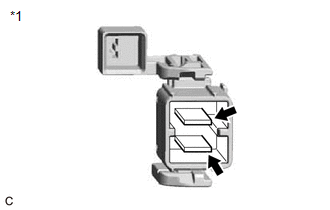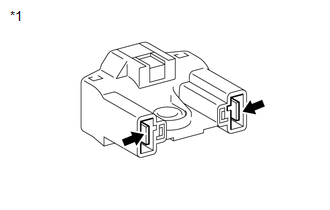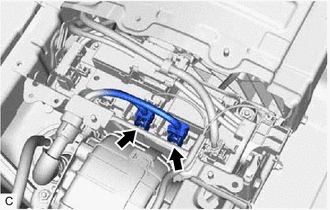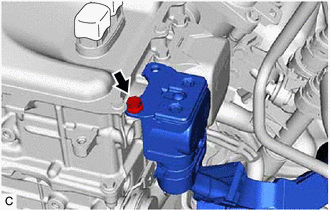Lexus ES: HV Battery High-voltage Line Circuit
DESCRIPTION
The cause of the malfunction may be the HV battery high-voltage line circuit.
Check the continuity in the high-voltage line from the HV battery to the inverter.
Check the connection condition and for an open circuit in the frame wire from the service plug grip, EV electric battery fuse and HV battery to the inverter and perform a function check of the system main relay.
Related Parts Check| Area | Inspection |
|---|---|
| High-voltage circuit from HV battery to inverter | Check connection condition and for open circuit. |
| Service plug grip | Check connection condition and for open circuit. |
| EV electric battery fuse | Check for open circuit. |
| System Main Relay | Check operation condition as relay. |
SYSTEM DESCRIPTION
The HV battery high voltage is supplied to the inverter via the system main relay operation.
WIRING DIAGRAM
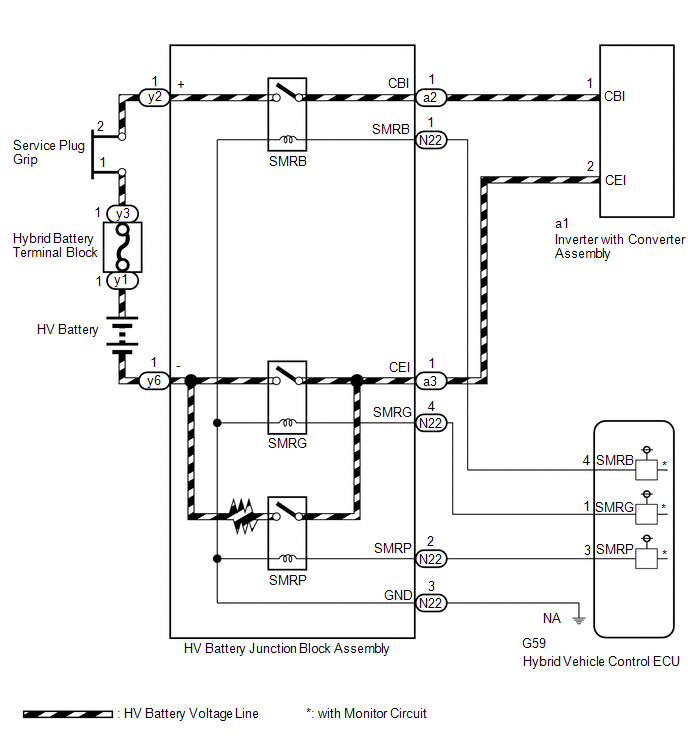
CAUTION / NOTICE / HINT
This diagnostic procedure is referenced to in the diagnostic procedure of several DTCs.
If the result of this diagnostic procedure is normal, proceed as directed in the procedure for the DTC.
CAUTION:
-
Before the following operations are conducted, take precautions to prevent electric shock by turning the power switch off, wearing insulated gloves, and removing the service plug grip from HV battery.
.png)
- Inspecting the high-voltage system
- Disconnecting the low voltage connector of the inverter with converter assembly
- Disconnecting the low voltage connector of the HV battery
-
To prevent electric shock, make sure to remove the service plug grip to cut off the high voltage circuit before servicing the vehicle.
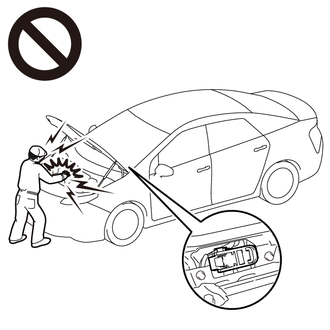
-
After removing the service plug grip from the HV battery, put it in your pocket to prevent other technicians from accidentally reconnecting it while you are working on the high-voltage system.
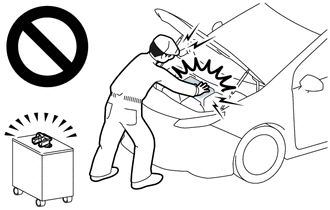
-
After removing the service plug grip, wait for at least 10 minutes before touching any of the high-voltage connectors or terminals. After waiting for 10 minutes, check the voltage at the terminals in the inspection point in the inverter with converter assembly. The voltage should be 0 V before beginning work.
Click here
.gif)
HINT:
Waiting for at least 10 minutes is required to discharge the high-voltage capacitor inside the inverter with converter assembly.

*a
Without waiting for 10 minutes
NOTICE:
After turning the power switch off, waiting time may be required before disconnecting the cable from the negative (-) auxiliary battery terminal. Therefore, make sure to read the disconnecting the cable from the negative (-) auxiliary battery terminal notices before proceeding with work.
Click here .gif)
.gif)
.gif)
.gif)
PROCEDURE
| 1. | CHECK INVERTER WITH CONVERTER ASSEMBLY (HV FLOOR UNDER WIRE CONNECTION CONDITION) |
CAUTION:
Be sure to wear insulated gloves.
(a) Check that the service plug grip is not installed.
NOTICE:
After removing the service plug grip, do not turn the power switch on (READY), unless instructed by the repair manual because this may cause a malfunction.
| (b) Check that the bolts for the HV floor under wire is tightened to the specified torque, the HV floor under wire is connected securely, and there are no contact problems. Specified Condition: T = 8.0 N*m (82 kgf*cm, 71 in.*lbf) |
|
(c) Disconnect the HV floor under wire from the inverter with converter assembly.
(d) Check for arc marks on the terminals for the HV floor under wire and inverter with converter assembly.
| Result | Proceed to | |
|---|---|---|
| The terminals are connected securely and there are no contact problems. | There are no arc marks. | A |
| The terminals are not connected securely and there is a contact problem. | There are arc marks. | B |
| The terminals are not connected securely and there is a contact problem. | There are no arc marks. | C |
| The terminals are connected securely and there are no contact problems. | There are arc marks. | B |
(e) Reconnect the HV floor under wire.
| B | .gif) | REPLACE MALFUNCTIONING PARTS |
| C | .gif) | CONNECT SECURELY |
|
| 2. | CHECK SERVICE PLUG GRIP (CONNECTION CONDITION) |
CAUTION:
Be sure to wear insulated gloves.
(a) Visually check the connection of the service plug grip to the HV battery. Remove the service plug grip and check for contamination.
OK:
Dirt or foreign matter has not entered the connectors, and there is no evidence of contamination.
(b) Install the service plug grip.
| NG | .gif) | REPLACE SERVICE PLUG GRIP |
|
| 3. | INSPECT SERVICE PLUG GRIP |
CAUTION:
Be sure to wear insulated gloves.
(a) Remove the service plug grip.
Click here .gif)
.gif)
.gif)
| (b) Measure the resistance according to the value(s) in the table below. Standard Resistance:
|
|
(c) Install the service plug grip.
| NG | .gif) | REPLACE SERVICE PLUG GRIP |
|
| 4. | CHECK HYBRID BATTERY TERMINAL BLOCK |
CAUTION:
Be sure to wear insulated gloves and protective goggles.
(a) Remove the Hybrid battery terminal block.
Click here .gif)
.gif)
| (b) Measure the resistance according to the value(s) in the table below. Standard Resistance:
|
|
(c) Install the Hybrid battery terminal block.
| NG | .gif) | REPLACE HYBRID BATTERY TERMINAL BLOCK |
|
| 5. | CHECK HV BATTERY JUNCTION BLOCK ASSEMBLY (HV FLOOR UNDER WIRE CONNECTION CONDITION) |
CAUTION:
Be sure to wear insulated gloves.
(a) Check that the service plug grip is not installed.
NOTICE:
After removing the service plug grip, do not turn the power switch on (READY), unless instructed by the repair manual because this may cause a malfunction.
(b) Remove the No. 1 HV battery cover panel RH.
Click here .gif)
.gif)
| (c) Check that the HV floor under wire is connected securely, and there are no contact problems. |
|
(d) Disconnect the HV floor under wire connectors from the HV battery junction block assembly.
(e) Check for arc marks on the terminals of the HV floor under wire and the HV battery junction block assembly.
| Result | Proceed to | |
|---|---|---|
| The terminals are connected securely and there are no contact problems. | There are no arc marks. | A |
| The terminals are not connected securely and there is a contact problem. | There are arc marks. | B |
| The terminals are not connected securely and there is a contact problem. | There are no arc marks. | C |
| The terminals are connected securely and there are no contact problems. | There are arc marks. | B |
(f) Reconnect the HV floor under wire connectors.
(g) Install the No. 1 HV battery cover panel RH.
| B | .gif) | REPLACE MALFUNCTIONING PARTS |
| C | .gif) | CONNECT SECURELY |
|
| 6. | CHECK FLOOR UNDER WIRE |
CAUTION:
Be sure to wear insulated gloves.
(a) Check that the service plug grip is not installed.
NOTICE:
After removing the service plug grip, do not turn the power switch on (READY), unless instructed by the repair manual because this may cause a malfunction.
(b) Remove the No. 1 HV battery cover panel RH.
Click here .gif)
.gif)
| (c) Disconnect the HV floor under wire connectors from the HV battery junction block assembly. |
|
| (d) Disconnect the HV floor under wire connector from the inverter with converter assembly. |
|
(e) Measure the resistance according to the value(s) in the table below.
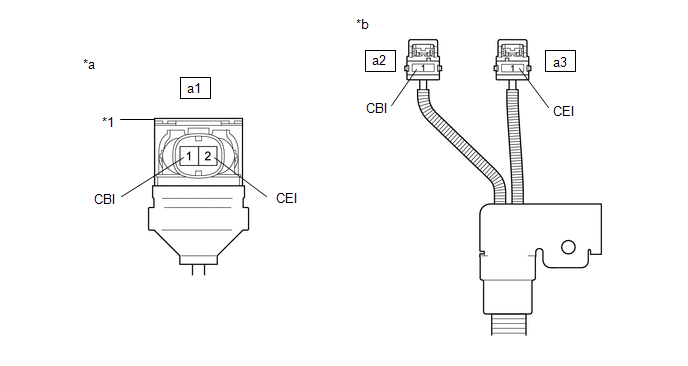
| *1 | Shield Ground | - | - |
| *a | HV Floor Under Wire (Inverter with Converter Assembly Side) | *b | HV Floor Under Wire (HV Battery Junction Block Assembly Side) |
Standard Resistance:
| Tester Connection | Condition | Specified Condition |
|---|---|---|
| a1-1 (CBI) - a2-1 (CBI) | Power switch off | Below 1 Ω |
| a1-2 (CEI) - a3-1 (CEI) | Power switch off | Below 1 Ω |
NOTICE:
Be sure not to damage or deform the terminal being inspected.
(f) Using a megohmmeter set to 500 V, measure the resistance according to the value(s) in the table below.
NOTICE:
Be sure to set the megohmmeter to 500 V when performing this test. Using a setting higher than 500 V can result in damage to the component being inspected.
Standard Resistance:
| Tester Connection | Condition | Specified Condition |
|---|---|---|
| a1-1 (CBI) or a2-1(CBI) - Body ground and shield ground | Power switch off | 10 MΩ or higher |
| a1-2 (CEI) or a3-1(CEI) - Body ground and shield ground | Power switch off | 10 MΩ or higher |
| a1-1 (CBI) - a1-2 (CEI) | Power switch off | 10 MΩ or higher |
| a2-1 (CBI) - a3-1 (CEI) | Power switch off | 10 MΩ or higher |
(g) Reconnect the HV floor under wire connector to the inverter with converter assembly.
(h) Reconnect the HV floor under wire connectors to the HV battery junction block assembly.
(i) Install the No. 1 HV battery cover panel RH.
| NG | .gif) | REPLACE FLOOR UNDER WIRE |
|
| 7. | INSPECT HV BATTERY JUNCTION BLOCK ASSEMBLY (SMRB) |
CAUTION:
Be sure to wear insulated gloves.
(a) Check that the service plug grip is not installed.
NOTICE:
After removing the service plug grip, do not turn the power switch on (READY), unless instructed by the repair manual because this may cause a malfunction.
(b) Remove the HV battery junction block assembly.
Click here .gif)
.gif)
(c) Measure the resistance according to the value(s) in the table below.
.png)
| *a | Component without harness connected (HV Battery Junction Block Assembly) | - | - |
Standard Resistance:
| Tester Connection | Condition | Specified Condition |
|---|---|---|
| y2-1 (+) - a2-1 (CBI) | Auxiliary battery voltage not applied between terminals N22-1 (SMRB) and N22-3 (GND) | 10 kΩ or higher |
| y2-1 (+) - a2-1 (CBI) | Auxiliary battery voltage applied between terminals N22-1 (SMRB) and N22-3 (GND) | Below 1 Ω |
(d) Measure the resistance according to the value(s) in the table below.
Standard Resistance:
| Tester Connection | Condition | Specified Condition |
|---|---|---|
| N22-1 (SMRB) - N22-3 (GND) | -40 to 80°C (-40 to 176°F) | 25.0 to 59.0 Ω |
(e) Install the HV battery junction block assembly.
| NG | .gif) | REPLACE HV BATTERY JUNCTION BLOCK ASSEMBLY |
|
| 8. | INSPECT HV BATTERY JUNCTION BLOCK ASSEMBLY (SMRG) |
CAUTION:
Be sure to wear insulated gloves.
(a) Check that the service plug grip is not installed.
NOTICE:
After removing the service plug grip, do not turn the power switch on (READY), unless instructed by the repair manual because this may cause a malfunction.
(b) Remove the HV battery junction block assembly.
Click here .gif)
.gif)
(c) Measure the resistance according to the value(s) in the table below.
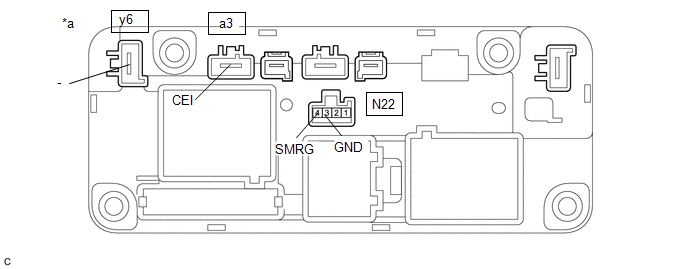
| *a | Component without harness connected (HV Battery Junction Block Assembly) | - | - |
Standard Resistance:
| Tester Connection | Condition | Specified Condition |
|---|---|---|
| y6-1 (-) - a3-1 (CEI) | Auxiliary battery voltage not applied between terminals N22-4 (SMRG) and N22-3 (GND) | 10 kΩ or higher |
| y6-1 (-) - a3-1 (CEI) | Auxiliary battery voltage applied between terminals N22-4 (SMRG) and N22-3 (GND) | Below 1 Ω |
(d) Measure the resistance according to the value(s) in the table below.
Standard Resistance:
| Tester Connection | Condition | Specified Condition |
|---|---|---|
| N22-4 (SMRG) - N22-3 (GND) | -40 to 80°C (-40 to 176°F) | 25.0 to 59.0 Ω |
(e) Install the HV battery junction block assembly.
| OK | .gif) | HV BATTERY HIGH-VOLTAGE LINE CIRCUIT NORMAL (PERFORM NEXT STEP FOR REFERENCED DTC) |
| NG | .gif) | REPLACE HV BATTERY JUNCTION BLOCK ASSEMBLY |


.gif)
